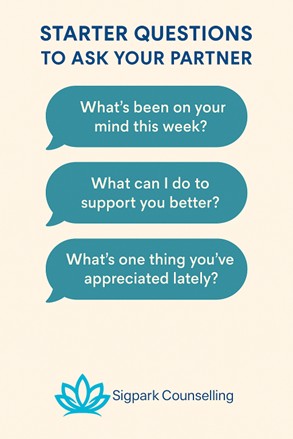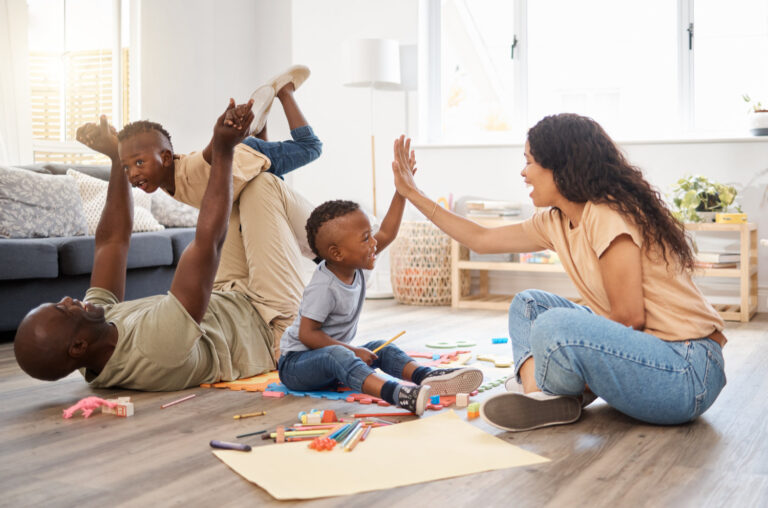How to Improve Communication in Your Relationship
Couples Communication Tips from Sigpark Counselling in Vancouver
Let’s be real—no one teaches us how to communicate in a relationship.
We figure it out as we go. Some of us avoid conflict until it builds up and explodes. Others talk over each other, hoping our point will finally land. And many couples—maybe even you—feel like they’re trying, but somehow missing each other entirely.
Sound familiar?
You’re not alone.
In fact, poor communication is one of the top reasons couples seek counselling in Vancouver and across Canada. It’s not always about the big arguments—sometimes, it’s the lack of meaningful conversation that slowly drives a wedge between partners. The drifting apart. The “we don’t talk like we used to.” The quiet resentment.
At Sigpark Counselling, we’ve seen it all. Couples who argue every day. Couples who haven’t had a deep conversation in months. And couples who love each other deeply but still struggle to say what they really mean.
Here’s the truth: the best relationships don’t happen by accident.
They’re built—one intentional conversation at a time.
And it’s a skill. One you can learn, practise, and get better at—together.
Whether you’ve been together two years or twenty, whether you’re dating, married, or somewhere in between, improving your communication can breathe life back into your relationship. And it doesn’t require a total overhaul. Sometimes, just a few small changes—how you listen, how you respond, how you share—can create a major shift in how you connect.
So if you’re wondering how to stop talking at each other and start truly understanding each other, you’re in the right place.
In this blog, we’re going to break it all down:
✅ The real reasons couples struggle to communicate
✅ Proven strategies that work (including tools we use in therapy every day)
✅ Expert insights from top relationship counsellors
✅ Resources to help you go deeper
✅ And a few myths that are getting in your way
Let’s dive in.
Because better communication doesn’t just solve problems—it brings back that sense of partnership you’ve been missing.
Use “I” Statements to Share, Not Blame
Let’s face it—when emotions run high, it’s easy to slip into blame mode. We say things like:
- “You never listen to me.”
- “You always do this.”
- “You don’t even care.”
Sound familiar?
These phrases might feel justified in the moment—but they rarely get the response you’re hoping for. Why? Because they trigger defensiveness. Your partner hears an attack, not a concern. And once that wall goes up, communication breaks down fast.
Now here’s the shift that changes everything:
Instead of pointing fingers, start by owning your feelings.
That’s the power of an “I” statement.
🟢 “I feel dismissed when I share something and don’t get a response.”
🟢 “I get overwhelmed when we argue late at night—I need time to cool off.”
🟢 “I feel lonely when we don’t spend time together on weekends.”
Notice the difference?
You’re still expressing the same issue—but now you’re inviting empathy instead of resistance.
This technique comes straight from Emotionally Focused Therapy (EFT), one of the most effective approaches we use at Sigpark Counselling. Studies show that couples who learn to use “I” statements report lower levels of conflict and a deeper sense of emotional connection. [The Relationship Center]
Here’s the formula:
I feel [emotion] when [situation] because [why it matters]. What I need is [clear ask].
📝 Example:
“I feel disconnected when we go to bed without talking. I miss those little check-ins. What I need is 10 minutes to chat before we sleep.”
Simple? Yes. Easy? Not always.
But with practice, this one tool can completely reshape the way you and your partner talk—and listen—to each other.
Practice Active Listening
The skill that makes your partner feel heard—even when you don’t see eye to eye.
You’re not just listening to words. You’re listening to emotion. To meaning. To what’s underneath the surface.
That’s active listening—and it’s one of the most powerful (and underused) communication tools in any relationship.
Most couples think they’re listening when they’re really just waiting to respond. You’ve been there, right?
- Your partner’s talking, and you’re already forming your defence.
- You nod, say “okay,” but miss the point.
- You interrupt—or completely misread the tone.
It’s not intentional. But it’s a fast track to feeling misunderstood.
Now imagine this instead:
Your partner shares something hard… and you pause.
You make eye contact.
You say, “I hear you.”
You reflect back what they said.
You validate their experience—even if you don’t agree with it.
That’s active listening in action.
Here’s the 3-step formula we teach at Sigpark Counselling:
🧠 Step 1: Pause and Make Eye Contact
Put your phone down. Turn toward them. Be present. This signals, “I’m here. I care.”
🧠 Step 2: Reflect Back What You Heard
This doesn’t mean repeating word-for-word—it means paraphrasing the feeling and the message.
“So you’re saying you felt totally overwhelmed with everything on your plate today, and it frustrated you when I didn’t offer to help—did I get that right?”
This one step alone can diffuse tension in seconds.
🧠 Step 3: Validate—Even If You Don’t Agree
Validation doesn’t mean agreement. It means acknowledgement.
“That makes sense. I can see how that would stress you out.”
“I get why that hurt you, even if I didn’t intend it that way.”
Why does this matter so much?
Because when your partner feels emotionally safe, they stop bracing for judgment—and start opening up. Emotional safety is the foundation of any thriving relationship.
In fact, active listening and validation are core elements in nearly every evidence-based couples therapy model—including Emotionally Focused Therapy (EFT), the Gottman Method, and Imago Dialogue—each backed by decades of relationship science and clinical results.
Want to try this at home? Here’s a quick exercise:
📝 The “5-Minute Turn-Taking” Drill:
- Set a timer for 5 minutes. One person speaks. The other listens, without interrupting.
- When time’s up, the listener reflects what they heard.
- Switch roles.
Try it with something low-stakes at first (like how your day went). Then use it to tackle more emotional conversations.
You’ll be amazed at how much smoother—and more loving—your communication becomes.
Create Time for Meaningful Check-Ins
Because not every conversation needs to be a crisis management session.
Here’s a truth most couples miss:
You don’t build strong relationships in the middle of an argument—you build them between the arguments.

And yet, for many couples, most conversations revolve around logistics (like bills or the kids) or conflicts (like the dishes or the in-laws). There’s no space left to simply connect.
At Sigpark Counselling, we call these quiet moments of reconnection “check-ins.” They’re small, intentional conversations that help you reconnect emotionally—and they work like magic.
“It’s like a pressure release valve for your relationship. When you check in regularly, tension doesn’t have a chance to build up.”
— Sangeeta Sirohi, RCC and founder of Sigpark Counselling
You don’t need a fancy date night or three-hour heart-to-heart.
Just set aside 10–20 minutes each week. Sit down. No phones. No distractions. Just you, your partner, and a few simple questions.
Here’s your starter script:
🗣️ What’s been on your mind this week?
This helps your partner open up about what’s weighing on them—whether it’s work stress, family stuff, or something internal.
🗣️ What can I do to support you better?
This shifts the focus from criticism to collaboration. Instead of pointing fingers, you’re offering partnership.
🗣️ What’s one thing you’ve appreciated lately?
This is your secret weapon. Sharing small moments of gratitude builds emotional intimacy faster than any relationship hack out there.
Why Check-Ins Matter (According to Science)
Research from the Gottman Institute—a leading authority on relationship health—shows that couples who create regular “rituals of connection” are more emotionally attuned, more satisfied in their relationship, and better equipped to weather stressful seasons.
These rituals don’t have to be complex. They just need to be consistent.
Think:
- Sunday morning coffee and a walk
- Friday night 15-minute recap
- A journal you pass back and forth weekly
- Five minutes before bed, every night, to share one thing that mattered that day
It’s not about the format—it’s about the intentionality.
When you carve out time to ask, “How are you, really?”—your partner stops being your co-parent, roommate, or problem-solver. They become your person again.
🟩 Quick Tip: Schedule your check-in like an appointment. Put it on your calendar. Protect it. Show up to it with the same care you would for a client, a class, or a friend in need.
Bottom Line: Consistent check-ins keep the emotional connection alive—so you’re not just coexisting… you’re growing, together.
Watch Your Body Language
Because sometimes, your silence is louder than your words.
Let’s say your partner is opening up about something important. They’re being vulnerable. Honest.
And you’re…
- Looking at your phone
- Folding your arms
- Staring into space
- Letting out a big sigh
You didn’t say anything harsh—but the message was loud and clear:
“I don’t care.”
Here’s the deal: in relationships, what you say matters—but how you say it matters more.
According to research from Dr. Albert Mehrabian, only 7% of communication is verbal. The rest? It’s tone (38%) and body language (55%). [Source: Psychology Today]
So when it comes to communication, don’t just focus on your words. Pay attention to what your body is saying.

Here’s What Supportive Body Language Looks Like
✅ Keep your arms uncrossed. This signals openness—not defence.
✅ Face your partner directly. It shows you’re present and engaged.
✅ Nod occasionally. It’s a small but powerful way to say, “I’m with you.”
✅ Maintain soft eye contact. You’re not interrogating—you’re connecting.
✅ Lean in slightly. This signals interest, especially during emotional conversations.
Now here’s what not to do:
🚫 Avoid eye-rolling. It screams contempt—one of the biggest predictors of divorce, according to the Gottman Institute.
🚫 Don’t multitask. Texting or checking email mid-convo says, “You’re not worth my full attention.”
🚫 Don’t sigh, scoff, or use dismissive gestures. They create instant emotional distance.
Want a quick test?
Think back to your last disagreement.
Did you:
- Cross your arms?
- Look away?
- Walk out mid-sentence?
Chances are, your partner remembers that moment more than what you actually said.
In fact, at Sigpark Counselling, we often have couples role-play real conversations in session—then review not just their words, but their non-verbal habits. Once they become aware of their body language, their conversations start to shift almost instantly.
“Your body can either build a bridge—or build a wall. You choose.”
— Sangeeta Sirohi, RCC
Pro Tip: Mirror Your Partner
This isn’t about mimicking. It’s about subtly matching their energy and posture in a way that builds trust. It’s called “nonverbal mirroring,” and it’s often used in conflict resolution and negotiation.
🧠 When they lean in, lean in.
🧠 When they soften their voice, lower yours.
🧠 When they open their hands, do the same.
It’s a quiet way of saying: I’m safe. I’m open. I’m listening.
Bottom line: You can say all the right things—but if your face, hands, and body say otherwise, your partner will feel it.
Don’t Let Stress Talk for You
Because sometimes your partner isn’t the problem—life is.
It’s 6:30 p.m.
Dinner’s not made.
The kids are melting down.
Your inbox is still full.
And somehow, your partner just left a towel on the floor again.
And suddenly… boom 💥
You snap.
But let’s be honest—was it really about the towel? Or was it about the day you’ve been carrying on your shoulders?
When stress piles up—whether it’s finances, work pressure, parenting demands, or just daily overload—couples often start misfiring. You take your stress out on the most available person… the one you live with.
That doesn’t make you a bad partner.
It makes you human.
But it’s also a pattern you can change.
At Sigpark Counselling in Vancouver, one of the first things we help couples recognize is the difference between the issue and the trigger. If you don’t know what you’re really reacting to, it’s easy to spiral into unnecessary conflict.

Here’s How to Stop Stress From Hijacking Your Relationship
🧠 Step 1: Pause and Ask Yourself—“What’s Really Going On?”
Before snapping, take a breath and ask:
“Am I upset about this… or am I just overwhelmed by everything else right now?”
This moment of reflection alone can save you from a full-blown argument.
🧠 Step 2: Take a Tactical Break
If you feel your heart racing, your tone sharpening, or your face getting hot—you’re in fight-or-flight mode. Your brain is primed to defend, not connect.
Say something like:
“I want to talk about this, but I need 10 minutes to cool off.”
Then walk. Stretch. Breathe. Come back when your nervous system has calmed down.
🟩 Pro tip: This isn’t avoidance. It’s regulation.
🧠 Step 3: Return with Curiosity, Not Combat
When you come back, reframe the conversation.
Instead of:
“You never help around here!”
Try:
“I’ve had a really tough day, and I’m feeling burnt out. Can we talk about how to share the load this week?”
This change in tone—from attack to vulnerability—makes it easier for your partner to respond with care, not defensiveness.
What the Research Says
A 2022 study published in Couple and Family Psychology found that couples who actively acknowledge external stressors—and support each other through them—are more resilient and satisfied in their relationships. [APA PsycNet]
In other words, naming your stress out loud can prevent you from misdirecting it.
Normalize Saying:
- “I’m on edge because of work, not because of you.”
- “I’m feeling overwhelmed—can I get a little support today?”
- “Let’s tag-team dinner tonight. I’m wiped.”
These moments of awareness don’t just reduce conflict. They build trust. They show your partner that even in hard times, you’re still a team.
Learn Your Partner’s Communication Style
Because how you say things matters just as much as what you say.
Here’s a little secret that saves relationships:
Your partner isn’t broken.
They’re just wired differently.
Maybe you need to talk it out right away.
But your partner? They need space to breathe before they can say a word.
You want to process together.
They want to process alone.
And suddenly—boom—you’re both frustrated, misreading each other, and thinking,
“Why are they like this?”
The answer?
Communication styles.
And no—yours aren’t better. They’re just different.
The 2 Most Common Communication Differences in Couples
🧠 External Processors: These folks talk to think. They work through feelings out loud. Silence can feel like rejection. The more they talk, the more they understand themselves.
🧠 Internal Processors: These people think to talk. They need time and space to sort their thoughts before they’re ready to share. Being pushed to speak too soon feels overwhelming.
Neither is wrong.
But without understanding these styles, it’s easy to assume the worst:
- “They’re shutting me out.”
- “They don’t care.”
- “They’re smothering me.”
- “They never want to solve anything.”
Sound familiar?
So How Do You Bridge the Gap?
✅ Have a conversation about your styles. Ask:
“Do you feel better talking right away, or after some time to think?”
“What helps you feel heard when things get tense?”
“When do you feel most open to connection?”
✅ Respect each other’s default mode—and meet halfway.
If your partner needs space, let them know you’ll reconnect soon.
If your partner wants to talk, agree on a time to revisit the topic so they don’t feel dismissed.
✅ Create shared signals.
We help couples build phrases like:
“I’m not ignoring you—I just need 30 minutes to collect my thoughts.”
or
“Can we talk now? I’m ready to listen.”
Pro Tip: Therapy Helps You Meet in the Middle
Let’s be real—changing communication habits is hard when emotions are high. That’s why couples counselling creates a safe space to slow things down, hear each other clearly, and build new communication rhythms that work for both of you.

When in Doubt, Ask More Questions
Because guessing gets you nowhere—but asking builds connection.
Ever had a conversation go sideways, and you weren’t even sure why?
You thought you were helping.
You offered a solution.
But your partner seemed… frustrated. Or distant. Or even more upset.
Here’s what might have gone wrong:
You responded when you should’ve asked.
One of the most powerful things you can do in a relationship—especially when the emotions are high or the issue is unclear—is this:
Ask. More. Questions.
Not in an interrogating way. Not to be “right.”
But to understand.
“Questions open the door to connection. Assumptions slam it shut.”
— Sangeeta Sirohi, RCC, Sigpark Counselling
Here Are 2 Game-Changing Questions to Use Right Away:
🟢 “Do you want advice right now, or just someone to listen?”
This question alone can save you from dozens of arguments.
Why? Because most people don’t want solutions—they want validation first.
They want to be heard, not fixed.
🟢 “Can you help me understand what you need from me right now?”
This keeps the conversation focused, intentional, and calm. It shifts you from reacting to responding—and shows you’re invested in getting it right.
And guess what? When your partner feels safe and understood, they’re more likely to open up and give you what you need, too.
More Great Connection Questions:
- “What’s really bothering you underneath all this?”
- “How can I support you in a way that actually feels helpful?”
- “Are we okay right now—or is something else coming up?”
- “Is there something I missed that would help me understand?”
These aren’t soft questions. They’re smart ones.
They stop the blame game.
They reduce confusion.
They invite intimacy—even in conflict.
Why This Works (According to Psychology)
Open-ended questions activate a different part of the brain—the one focused on reflection, not defence. According to research on emotional attunement, partners who practise responsive inquiry experience less stress, more satisfaction, and better long-term conflict resolution.
Quick Tip: Don’t Stack Questions
Slow it down. Ask one question. Pause.
Give your partner space to reflect and respond.
This creates calm, connected conversation—instead of an overwhelming interrogation.
Bottom line: When you’re not sure what your partner needs, don’t assume.
Ask.
The right question could be the key to unlocking the conversation you’ve been waiting for.
Final Thoughts: Small Shifts Create Big Results
Let’s recap what you’ve learned:
✅ How to use “I” statements instead of blame
✅ How to practise active listening that makes your partner feel heard
✅ Why body language and timing matter as much as words
✅ How attachment styles and stress shape how you communicate
✅ The power of asking better questions—and checking in regularly
✅ When to stop guessing and start getting support
The truth?
You don’t need to overhaul your whole relationship overnight.
But you do need to start.
Even one small shift—like pausing before reacting, softening your tone, or listening without interrupting—can spark a powerful ripple effect.
You’ll feel it.
Your partner will feel it.
And over time, it changes everything.
Because the best relationships don’t happen by accident.
They’re built—one intentional conversation at a time.
📞 Ready to start? Let’s talk.
Book your free 15-minute consultation with Sigpark Counselling today.
Whether you’re struggling with communication, trust, parenting stress, or just feeling disconnected—we’re here to help you build the relationship you actually want.







